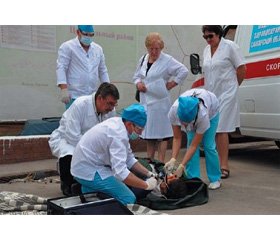Журнал «Медицина неотложных состояний» 7 (62) 2014
Вернуться к номеру
Simulation forms training for emergency medical services crews
Авторы: Lyovkin О., Goldovskiy B., Serikov К. — State Institute "Zaporizhzhia Medical Academy of Postgraduate Education of Ministry of Health of Ukraine", Zaporizhzhia, Ukraine
Рубрики: Медицина неотложных состояний
Разделы: Справочник специалиста
Версия для печати
cardiopulmonary resuscitation, prehospital period, simulation forms training.
Rapid development of scientific and technological advances in medicine, new technologies, modern equipment have changed the requirements for the professional level of emergency medical services crews highlighting the problem of improving medical postgraduate education.
Simulation form training for emergency medical services crews, where specially trained in artificially created imitated setting is most appropriate. The main quality simulation training — the use of dummies for completeness and realistic modeling of objects in a given situation; testing of specific practical skills using modern equipment without causing harm to human health; practicing team work in a particular situation.
Objective: to determine the basic knowledge and skills of emergency medical services crews to conduct cardio-pulmonary resuscitation in the prehospital period using current devices and equipment; determine the effectiveness of simulation training.
Measurements and main results. A рrospective analysis of teaching and support of learning and practical skills CPR of emergency medical services crews. The research included 86 of emergency medical services crews. Where are 36 physicians, 86 assistants of the physician, 86 medical orderlies. The average age of employees emergency medical services crews was 46.6 ± 8.4 years, work experience — 13.6 ± 9.4 years. Training of emergency medical services crews was conducted according to 6 hour training program "Basics life support" according to a unified clinical protocols of emergency medical care "sudden cardiac death" and European Resuscitation Council Guidelines for Resuscitation 2010. Classes are conducted using dummies "Airway Management Trainer", Resusci Anne (Laerdal) and Monitor/Defibrillator HeartStart MRx (Philips), automatic external defibrillator AED Pro (Zoll), unit ventilator «Medumat Standard a» (Germany), Rescue Pack for respiratory support using і-gel or laryngeal mask airway and Ambu.
Results. The results of the analysis indicate a sufficient base level of theoretical knowledge of algorithm CPR unified clinical protocols of emergency medical care "sudden cardiac death" and ERC guidelines 2010 (questions diagnosis of death, quality compress the chest, pharmacological support).
Also, the results of the analysis indicate a low level of basic practical skills to restore the airway using i-gel, LMA from physicians (32.8 ± 2.2 %), assistants of physician (18.3 ± 2.1%) and medical orderlies (9.0 ± 2.1 %). After 6 hours of classes the level of practical skill to restore airway using i-gel, LMA was significantly increased to 76.4 ± 3.2 % from physicians, to 68.5 ± 1.8 % assistants of physician and to 34.4 ± 2.3 % — medical orderlies.
The results of the analysis indicate a low level of basic practical skills of using the monitor/defibrillators HeartStart MRx (Philips) and automatic external defibrillator AED Pro (Zoll) of physician, assistants of physician and medical orderlies. After 6 hours of classes the level of practical skills for working with monitor/defibrillators was significantly increased (from 38.5 ± 3.0 to 79.8 ± 2.4 % of physicians, from 12.5 ± 2.5 to 64.8 ± 2.5 % of assistants of physician and from 1.8 ± 1.5 to 28.5 ± 1.8 % of medical orderlies).
Simulation training found some problems of consistency in team work emergency medical services crews. Were fixed such problems as lack of noisy short orders; lack of clear understanding and action in the team during change; lack of a clear division of responsibilities in the team during CPR; lack of desire to use leadership team witnesses as potential helpers in conducting CPR; lack of opportunity to some physicians or assistants of physician to be the leader of the team.
Conclusions: 1. Sufficient basic theoretical knowledge of algorithm by conducting CPR physicians and assistants of physician emergency medical services crews. 2. Low base level of skills to restore the airway using i-gel, LMA and using the monitor/defibrillators physicians, assistants of physician, medical orderlies. 3. Ability simulation training to quickly improve the practical training of emergency medical services crews. 4. Simulation training ability to detect and correct problems in the coordination of the work team emergency medical services crews.
1. Pro zatverdzhennya ta vprovadzhennya medyko-tekhnolohichnykh dokumentiv zi standartyzatsiyi ekstrenoyi medychnoyi dopomohy [chynnyy vid 15.01.2014] – 2014 - (Nakaz MOZ Ukrayiny # 34).
2. Nahornaya N.V., Dudchak A.P., Dmytruk V.Y., Parshyn S.A. Metod povыshenyya эffektyvnosty usvoenyya navыka serdechno-lehochnoy reanymatsyy vrachamy-ynternamy. Vestnyk neotlozhnoy y vostanovytel'noy medytsynы. 2011; 4:11-12.
3. Konnova L.A. Sovremennыy podkhod k obuchenyyu metodyke serdechno-lehochnoy reanymatsyy pry okazanyy pervoy pomoshchy na meste proysshestvyya. Vestnyk nauchnыy tsentr bezopasnosty zhyznedeyatel'nosty. 2011; 4 (10): 43-48.
4. Ekhalov V.V., Slyva V.Y., Stanyn D.M., Lyashchenko O.V., Klyhunenko E.N. Pryntsypы podhotovky vrachey-ynternov raznыkh spetsyal'nostey po tsyklu «Neotlozhnыe sostoya¬nyya» Medytsyna neotlozhnыkh sostoyanyy.2011; 4: 124-129.
5. European Resuscitation Council Guidelines for Resuscitation 2010/ Resuscitation. – 2010; 81.

